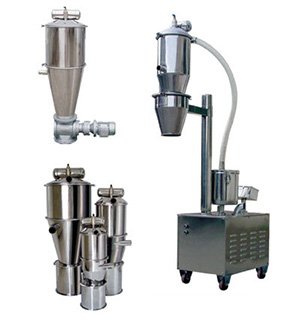In the previous article on conveyors, we mentioned belt conveyors, belt chain bucket conveyors and Z-type feeders. It is not difficult to find that these machines are more suitable for granular and solid products. If you are a powder or small granular product, and hope to reduce the pollution of product raw materials during transportation, then we will introduce you to several feeders/conveyors suitable for powder and granules.
Screw Feeder/Screw Conveyor
The screw feeder is mainly composed of drive motor, screw conveyor rod, hopper, feed port and discharge port. Among them, the powder screw can be replaced with different shapes according to different material forms. Different kinds of powder conveyor are optional, fits sundry characters of powder.

Working principle:
When working, the drive motor reduces the speed and increases the torque through the reducer, driving the screw conveyor rod to rotate in the barrel. After the material enters the barrel from the feed port, it moves axially along the inner wall of the barrel under the push of the spiral blade. Due to the rotation of the spiral blades, the material is constantly squeezed and pushed, gradually moving towards the discharge port, and finally discharged from the discharge port to complete the feeding process. By adjusting the speed of the motor, the material delivery volume can be accurately controlled to meet the needs of different production processes.
Application:
The screw feeder can be used in a variety of industries such as chemical raw materials, food processing, drug production, plastic processing and other industries. It is suitable for various powdered and granular chemical raw materials, powdered materials such as powder, sugar powder, milk powder, and granular materials such as grains and nuts, plastic granules, powdered raw materials of drugs, etc. The screw feeder can meet the food-grade hygiene and safety standards and the strict quality control requirements of the pharmaceutical industry with its high-precision quantitative delivery and good sealing.

Advantages:
- The screw feeder can achieve accurate metering and quantitative delivery of materials. By controlling the speed and number of rotations of the screw conveyor rod, the material delivery volume per unit time can be accurately controlled with a small error range.
- The screw feeder has a compact structural design and a small footprint, and can be flexibly arranged according to the actual space of the production site.
- Since the spiral conveying rod works in a sealed barrel, the noise is low during transportation.
- This equipment is suitable for materials in various forms, especially in the transportation of powdered materials (such as flour, cement, pigments) and granular materials (such as plastic particles, grains, fertilizers).
Vacuum Feeder/Vacuum Conveyor
The vacuum feeder is mainly composed of vacuum pump, suction nozzle, conveying pipeline, filter, silo, discharge valve and other components.

Working principle:
When working, the vacuum pump starts to form a vacuum environment in the conveying system and at the entrance of the suction nozzle. The material near the suction nozzle is sucked into the conveying pipeline under the action of atmospheric pressure, and then transported to the silo through the pipeline. When the silo is full of materials, the vacuum pump automatically closes and the pressure in the conveying equipment reaches equilibrium. The discharge valve opens, and the material flows out through the discharge port and falls directly into the storage container.
Application: The vacuum feeder can not only convey powdered materials such as flour, milk powder, chemical powder, etc., but also granular materials such as plastic particles and grains. For some lightweight and fluid materials, its conveying effect is particularly significant.
Advantages:
- Automatic loading and unloading reduces manual operation and labor costs.
- The suction force generated by the vacuum can quickly suck the material into the conveying system, increasing the material conveying speed.
- Since the material is conveyed under negative pressure, the dust of the material will not fly, reducing the pollution to the workshop environment.
- Due to the fully enclosed nature of vacuum transportation, it is more friendly to industries with high requirements for hygiene conditions such as food and medicine, and can ensure the quality and safety of the product.
It should be noted that the vacuum feeder needs to regularly clean the suction nozzle, conveying pipeline, silo and other components to prevent material residue and agglomeration from affecting the conveying efficiency. The filter is a key component of the vacuum feeder, and the filter element should be regularly checked and replaced after the work is completed.
Big Bucket Elevator
The big bucket elevator has a large capacity hopper for carrying materials. Unlike the previous small-scale conveyor, the big bucket elevator can convey more materials at a time due to its large hopper, which is suitable for the rapid handling of materials in large-scale production. It consists of a stainless steel hopper, a traction component, a motor, and a tensioning device.

Working principle:
The drive device drives the traction member to move, and the hopper circulates with the traction member. At the bottom, the hopper scoops up the material and then rises vertically along the track inside the casing. When the hopper reaches the top, the material is discharged by centrifugal force or gravity to achieve the transportation of materials from low to high.
Application: It is used to transport grain, flour, sugar and other materials in the food processing industry, cement, sand and gravel and other building materials in the building materials industry, and various chemical raw materials and finished products in the chemical industry, such as plastic particles, powdered chemicals, etc. Suitable for all kinds of large-capacity powders, solids and particles.
Advantages:
- It can achieve a higher vertical lifting height, which is suitable for multi-story factories or production environments with large height differences.
- Stable operation reduces the probability of material spillage and equipment failure.
- Suitable for industries that require large amounts of raw materials and high production capacity.
